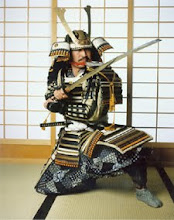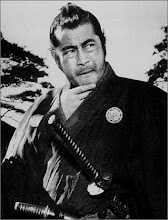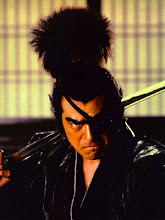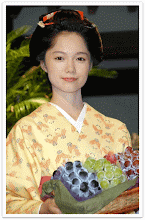33 years ago back in 1980 when this author was a young teenage boy, I once asked a former US Submariner of World War II why did he choose the Submarine Force? US Navy Veteran Fred Moore replied, “Because you don't see too many one armed, one legged, or one eyed Submariners. Well for Captain Kuramoto of the fictional I-77 it was “Freedom” in 2009's Submarine War Film Manatsu no Orion or Last Mission Under the Orion.
Based on Tsukusa Ikegami's novel “Raigeki Shindo Juukyuu-ten-go,” Manatsu no Orion takes place in the final two weeks of War II August 1945, the young crew of the I-77 under Captain Kuramoto Takayuki (Tamaki Hiroshi of Isoroku Yamamoto and The Amazing Deer Man) fight on. But where the film starts is in the present with the grand daughter of Captian Kuramoto who knows nothing about the war. Her grandfather died before she was born and only has few memories of her grandmother now conjured by a letter sent to her by an American.
Because of this, school teacher Kuramoto Izumi (Kitagawa Keiko) meets one of the last surviving crew members of the I-77 Suzuki Katsumi in an effort to understand how an American who is the grandson of the American Captain Mike Stewart came to possess a piece of sheet music with a personal note from Izumi's grandmother who also was a school teacher caring for orphans Arisawa Shiduko (also played by Kitagawa Keiko).
It was Suzuki who studied music who could read sheet music and once played a harmonica aboard the I-77 who could recall this tale of the last two weeks of the war. While this might sound like you've seen this before in Otoko Tachi no Yamato, Manatsu no Orion takes on a far different tone.
Enter the Charismatic Captain Kuramoto is tasked along with his friend, future brother in law, and captain of the I-81 Arisawa Yoshihiko (played by Dochin Yoshikuni) to stage a defensive picket line to both to attack allied shipping and protect Okinawa in a desperate attempt to save Japan.
Captain Kuramoto is unlike any Submarine captain you've seen before nor is his crew. While the doomed war effort scenario is not new, this depiction of Japan's all but defeated Imperial Navy is. In this film you'll see little known tactics used by Japanese Sub Captains as well torpedo firing solutions reminiscent of The Hunt for Red October as well as harrowing scenes of doomed men that will recall memories of such submarine dramas as Grey Lady Down and Das Boot.
But what really carries the premise of this film is the meaning contained on the piece of sheet music 'Oh' Orion' to which Captain Kuramoto's love interest Arisawa Shiduko has given him to carry off to war as an “Omori” - a good luck charm.
As seen in a scene while surfaced, Captain Kuramoto is well familiar with the Midsummer's appearance of the constellation Orion in the Southern Oceans and considers it a good omen. Along with a personal message the music piece reads “So that my love may find his way home.” And home is something Captain Kuramoto has very much in mind. In some ways, you could say he is somewhat of a romantic.
But war is anything but romantic. Much like seen in Otoko Tachi no Yamato, the Crew of the I-77 represents what little was left to fight with at the final stage of the war. What's left of Japan's Naval Forces are largely comprised of mostly teenagers and only a small handful of veteran sailors over 30.
With a compliment of fourteen remaining torpedoes, the I-77 is complimented with four Kaiten torpedo boats – Japan's underwater Kamikaze whose suicide mission is a one way ride commanded by a determined and somewhat indignant Toyama Hajime (played by Kikawada Masaya) to whom is in opposition to Captain Kuramoto's view that such suicide weapons are a waste of human life.
Notable characters include Ships Doctor Tsubota Makoto (played by Hiraoka Yuta), Ship's Engineer Kuwata Shinsaku (played by Yoshida Eisaku), young Suzuki (played by Taiga), Torpedo Officer Tamura Toshio (played by Masuoka Toru), Navigating Officer Nakatsu Hiroshi (played by Fukikoshi Mitsuru), and the Ships cook Akiyama Goro (played by Suzuki Taku).
So getting back to the war.... The I-77 (who many of the crew is on their first and final mission)and her sister I-81 are pursued by the US Destroyer USS Percival commanded by Captain Mike Stewart (played by David Winning) who has one of the highest kill record in the fleet. He is a determined Captain out to carry out his mission to hunt and sink the remaining Japanese Submarine threat.
Now what sets his character apart, is he seems to know something about Bushido. Now whether such a man could have existed as a destroyer captain or clearly the invention of the Japanese Writer Ikegami Tsukasa, it lends to the films pace. He knows his enemy and anticipates Kuramoto's moves in a battle of strategy and nerves in a cat and mouse game of death reminiscent of the WWII Classic The Enemy Below.
Captain Stewart makes for a ruthless pursuer who knows his enemy will not surrender. But what US Navy Captain Stewart doesn't know is that unlike many of his vanquished foes resting at the bottom of the Pacific, Captain Kuramoto has no intention of dying. Rather, he has everything to live for and much like the I-77's vitamin dispensing Doctor Tsubota, he cares very much for the safety and well being of his crew for he under no illusion that the war is already lost.
For Captian Kuramoto, he see's his teenage crew as men who will be needed for Japan's uncertain future. men on both sides who in another world would perhaps be friends if it had not been for war.
While Captain Stewart initially comes off like some heartless prick, he is a man doing his job that is the grim business that is war. As the film goes deeper into Stewart's psyche, he reveals himself to be much greater a character than the film gives him credit for. We'll give you a little hint: Stick around for the credits for a revealing added footage.
In the end, it is his care for Arisawa's sheet music that reveals Captain Stewart's overall humanity. He seems to respect his foe and their duty to fight to the death. But unlike many of his contemporaries and his frustrated Kaiten pilots. Kuramoto is fighting not to die, but to live.
Comparisons to other Submarine war dramas are inevitable. Unlike the sense of claustrophobia of the U-96 crew of Das Boot, the Japanese crew of I-77 seem very acclimated to their boat without complaint or want. Imagine that! Working with a crew without any vocal complainers! Ok, so we have one grim engineer but none of the usual angst seen in other submarine movies. Manatsu no Orion may not have the intensity or excitement of Das Boot, but in fairness to this big screen quality Toho Studios TV Asashi Movie, it's overall story and production value is far better and far more believable than Hollywood's Big Budget Submarine stinker U-571. And unlike fantasy movies like Lorelei – Witch of the Pacific or the cartoon parody of Japanese Submarine crews in Steven Spielberg's 1941, Manatsu no Orion depicts the unwavering professionalism of the Japanese Navy under fire.
It is such professionalism we may add that dismisses the myth that Japanese Submariners were unsuccessful or incapable in their undersea war against the US Navy. It is a little known fact that the Imperial Japanese Navy's Submarine force actually sunk a significant number of US and Allied Ships during the War. Sadly, their record is both obscured by the disastrous record of Japan's combined surface fleet and lingering prejudice here in America which we find strange considering today's Japan's current Navy is the second largest in the world and our number one allies in the Pacific.
It is such professionalism we may add that dismisses the myth that Japanese Submariners were unsuccessful or incapable in their undersea war against the US Navy. It is a little known fact that the Imperial Japanese Navy's Submarine force actually sunk a significant number of US and Allied Ships during the War. Sadly, their record is both obscured by the disastrous record of Japan's combined surface fleet and lingering prejudice here in America which we find strange considering today's Japan's current Navy is the second largest in the world and our number one allies in the Pacific.
While we can't give away the whole film or how Captain Stewart acquires the Sheet music, we can say we at American Mishima liked this film. It is a tribute to the sincere dedication and pure professionalism of Japan's Submarine Crews. While the film does not pull heavy on the heart strings like Otoko Tachi no Yamato, it does play on a very human element that one can not ignore. While predictable in places, we can say you will not be disappointed with it's story line, character development, use of model miniatures, detailed realistic CGI effects, and the use of an actual former US Navy Destroyers including one currently owned by Mexico.
But most importantly, it's likeable characters aboard the I-81 and I-77 that find you rooting for their survival. You want to survive. But of course war is ugly business. In any war film, there is always tragedy. But what sets this film apart and narrowly joining the cut above the rest of great submarine films (or war films for that matter) is when they touch upon humanity and our favorite Japanese theme: The Fragility of Life. We at American Mishima will grant The Last Mission Under the Orion just praise.
To find this film and other Japanese Films with English Subtitles,
Visit our man Eddie over at Japanese Samurai DVD




























































